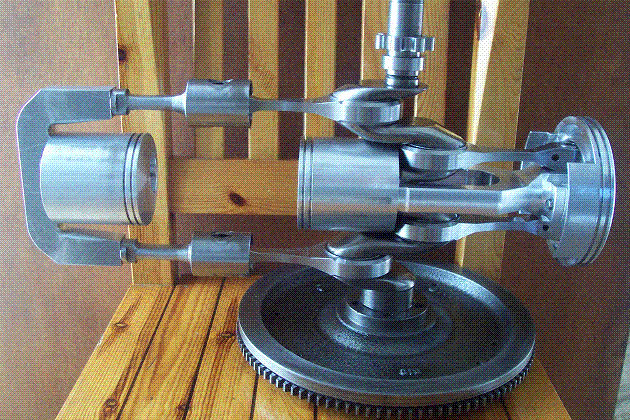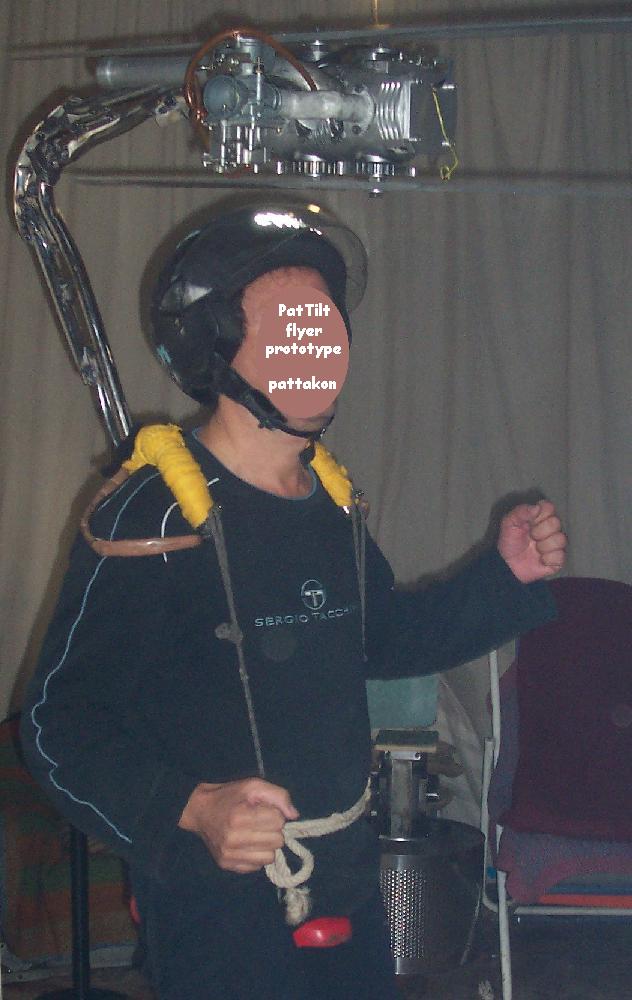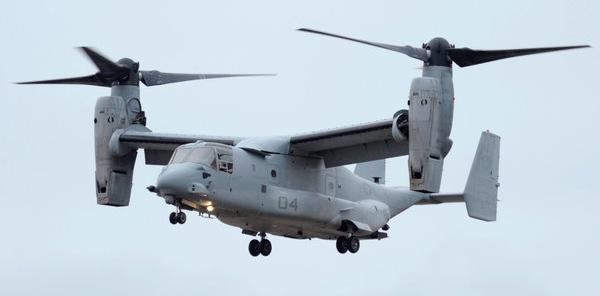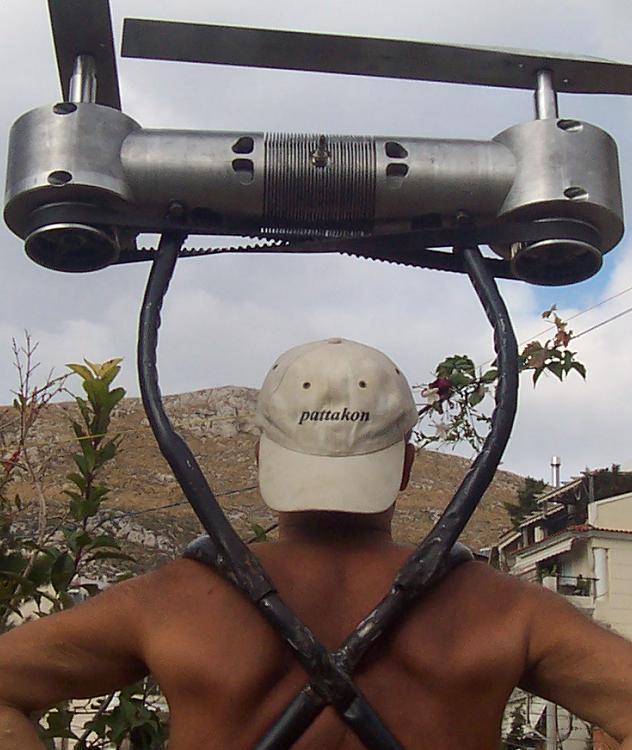Hello Big Dex
Thank you for your strictly technical questions.
You write:
“Do I understand that each of the 2 engines is capable of sustaining flight?”Yes.
You also write:
“So 1500N of thrust each?”No.
1,150N of thrust each.
Each engine, with the two propellers it drives, is capable for a thrust of 253lb / 115Kg / 1,150N allowing a safe emergency landing.
According the GoFly BOEING contest, the pilot weight should be 200lb (91Kg).
The dry weight of the device is 44lb (20Kg).
And for the Fly-Off test they are required, say, 5lb (2Kg) of fuel.
In total: 249lb (113Kg).
I.e. the thrust from the one engine is adequate for an emergency landing.
Closer to reality:
The average pilot weight is 165lb / 75Kg.
The PORTABLE FLYER dry weight is 44lb / 20Kg
The fuel weight (for a 300Km / 200 miles range) is 22lb / 10Kg.
Total take-off weight: 231lb / 105Kg.
I.e. the thrust from the one engine can give an upwards acceleration of ~1m/sec2
You also write:
“One of my aircraft has a Rotax 582; fairly well known as a very high power to weight ratio power unit; it creates 164kg of thrust; and it weighs 57kg dry, built with a pull-start for weight saving reasons. “The thrust an engine creates depends on the propeller it drives and on the transmission ratio used (crankshaft to propeller).
Let’s focus on the 57Kg dry weight of your Rotax 582 (which makes 48kW / 64bhp peak power).
It is a 580cc 2-stroke 2-cylinder rotary-valve spark ignition gasoline engine.
Let’s compare it with the PatOP prototype engine (more at
http://www.pattakon.com/pattakonPatOP.htm )
In the following GIF video they are shown the moving parts of the PatOP:

Here the PatOP prototype engine is free on a desk and is running on Diesel Fuel:
The PatOP is an:
opposed-piston,
two-stroke,
single-cylinder,
single-crankshaft,
full-balanced (vibration free),
cross-head,
direct-injection Diesel engine,
with built-in "volumetric" (for a wider rev range and flat torque curve) scavenging pump,
with four-stroke-like lubrication,
and with some 35%, as compared to the conventional engines, additional time for the injection and combustion of the fuel.
Bore: 79.5mm
Stroke: 64+64=128mm
Displacement: 636cc
Compression ratio: 17
Scavenging pump bore: 130mm (1.34 scavenging ratio; the capacity of the scavenge pump is 850cc).
Total engine height: 500mm
Total engine weight (without the flywheel): less than 20Kg (44lb)
The PatOP has one cylinder and two opposed pistons.
While the spark ignition Rotax 582 scavenges the cylinder with air-fuel-oil mixture, the PatOP scavenges its cylinder with air. The Diesel fuel is injected at the end of the compression with all ports closed.
With its substantially longer piston dwell at the combustion dead center (pulling rod architecture) the PatOP can burn its fuel efficiently at some 30% higher revs than the conventional Diesels.
The Peak power is expected at 6,000rpm (while the power of most Diesels peaks below 4,500 rpm.
The cooling fins of the PatOP are OK for its cooling.
So as compare to the Rotax 582, the PatOP weighs some three times less.
But it is more than just power to weight ratio:
The PatOP has some 10% bigger capacity,
it runs on compression ignition,
it runs on higher compression ratio (17:1),
it achieves fast combustion (most of the fuel is burnt while the pistons are still near their TDC),
it scavenges the cylinder by clean air (no unburned fuel in the exhaust),
it’s inertia forces and moments are perfectly balanced,
etc, etc.
It is a prototype engine.
If you want to make your own PatOP to test it, I can e-mail you the CAD drawing.
You also write:
“Your GIF of the engine design is interesting; and at 8kg it looks impressive; however that’s a single piston with no cylinder head or cooling systems (does it have a fuel system?).”The OPRE Tilting has two opposed pistons and a cylinder.
It is air cooled (the cooling fins on the cylinder are inside the downwash stream of the propellers).
The fuel system in the prototype of the following videos is a carburettor (as in the Rotax 582).
The PatBam version is to work on lean burn HCCI (throttle-less) and port injection that further simplifies the induction system.
Here is the OPRE Tilting prototype running at low revs:
here is the OPRE Tilting running at medium revs:
and here is the disassembly of the OPRE Tilting prototype:
and here is a photo wherein a guy “wears” an OPRE Tilting single-engine PORTABLE FLYER to show the arrangement and the size of it:

The above prototype engine capacity is 333cc.
You also write:
“I struggle to see how you can achieve a reliable 65hp engine with a mass of the order of 15kg.”No.
The 65hp is from each engine (not the toal).
The short piston stroke allows high revs.
The lightweight / cheap transmission (with sprockets and timing belt as in the final transmission of several motorcycles) enables the optimization of the revs of the engines and of the revs of the propellers.
For instance, with the OPRE Tilting running at 9,000rpm, the mean piston speed is only 9m/sec; and with 2.4:1 reduction ratio from crankshaft to propellers, the 39’’ propellers spin at 3,750rpm (tip speed: 195m/sec, 57% of sound velocity).
The 9m/sec mean piston speed is a slow reliable piston speed.
In comparison, the Rotax 582 (with 64mm piston stroke) makes 48kW at 6,500 rpm, wherein the mean piston speed is 14m/sec, which is a high speed for continuous reliable operation.
If the OPRE Tilting was to operate at the same mean piston speed, it would run at 14,000rpm.
You also write:
“If you can, I suggest that this vast improvement on anything ever achieved before should be the focus of your project; the aircraft is irrelevant!”You are right.
However, the best way to prove the engine advantages is to make it fly as in the PORTABLE FLYER.
And BOEING was supposed to give the opportunity to show it.
That’s why I gave them my 250USD and now I regret I was caught a sucker.
Thanks
Manolis Pattakos
 FLYER Club Member
FLYER Club Member



